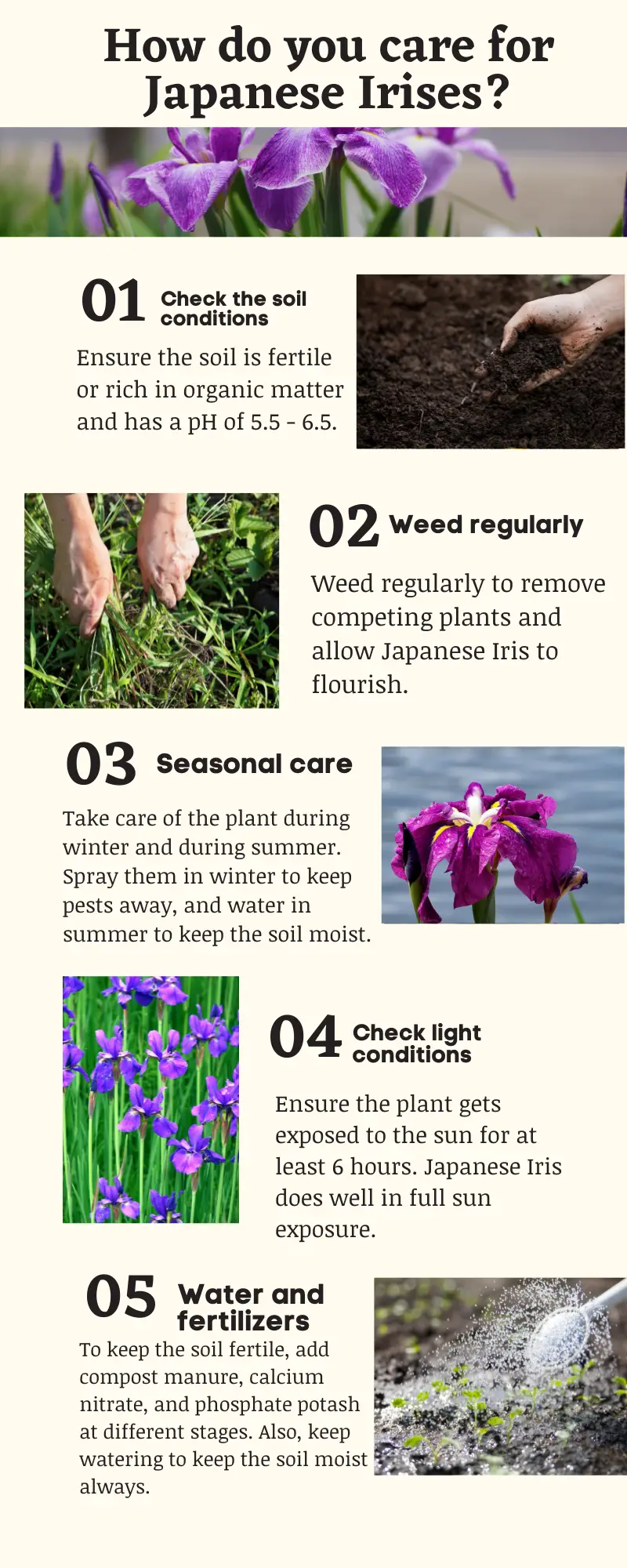Last Updated on February 23, 2022 by William
Japanese Iris Care
Japanese Iris belongs to the Iridaceae family, scientifically known as Iris ensata. This plant grows well in the Mediterranean warm climate and thus caring for it is minimal in these climates. The plant only needs some care during winter to keep it growing healthy.
For Japanese Iris to bloom, you need to pay attention to five things: soil conditions, weeding, seasonal care, light, watering and fertilization.
How to care for Japanese Iris in five steps:
- Check the soil conditions
- Weed regularly
- Seasonal care
- Check light conditions
- Water and fertilize
Check the soil conditions
This plant needs slightly acidic soil of pH 5.5 – 6.5. If the soil is too acidic or below a pH of 5.5, then you should add some lime to lower the acidity of the soil. The soil should also be rich in organic matter to help reduce deficiency. This is important especially for the soil with a pH of more than 7.5.
Weed regularly
Weeding will help remove unwanted plants or weeds that would otherwise compete with the Japanese Iris plant for nutrients. After transplanting the plant, you can mulch to help reduce the weeds. Also, during the rainy season, weeds tend to grow fast and you should always weed them out for the Japanese Iris plant to blossom.
Seasonal care
Seasonal care means taking care of the plant during seasons that are out of the required conditions. Summer for example can be dry and you will need to put proper preparations to ensure the plant gets adequate water throughout the season. Winter comes with its demands as well.
During this period, pests and bugs can breed under the leaves. You should always inspect for these bugs and pests and treat them with insecticide spray.
Check light conditions
Japanese Iris does well in full light and partial shade. You should ensure that the plant is not fully shaded by other plants but gets exposed to full light. It requires between 6 – 10 hours of full sun exposure for it to blossom and bloom.
Water and fertilizers
The Japanese Iris plant requires a lot of water throughout the year. The water helps keep the soil moist in all seasons. When the plant is growing more actively, ensure that it has enough water by doing proper irrigation. While doing irrigation, ensure the soil is not waterlogged.
You should begin fertilization a few weeks after cultivation. Normally, 3 – 4 weeks. You can apply calcium nitrate just after the extraction of the third leaf. Also, topdressing with phosphate potash fertilizer is recommended. This helps the plant not just to bloom but to resist lodging and diseases.
Infographic: How do you care for Japanese Irises?

Do Japanese Iris need full sun?
The Japanese Iris plant needs full sun to flourish. It can also do well in partial shade but should get sun exposure for a minimum of 6 hours. In the active stages of growth, Japanese Iris needs enough sun exposure and may become intolerant to too much shade.
Should Japanese Iris be divided?
Japanese Irises should be divided every 2 – 4 years. This is because the rhizomes grow underground and multiply hence the clumps get crowded and can affect the quality of the plant. Some of the signs that show when the plant needs division include:
- When the clumps become overgrown.
- When rhizomes start growing into each other.
You should, therefore, divide them when you see these signs and plant them in separate spots where there is full sun exposure.
Why are my Japanese Iris not blooming?
Japanese Iris only blooms when the right conditions are kept. That ranges from the condition of the soil, whether there are pests, and whether the caring and dividing have been done at the right time. Therefore, if your plant is not blooming, check the conditions, and ensure there is no overcrowding, pests, and bugs, as well as other conditions.
Japanese Iris bulbs
The Japanese Iris bulbs are separated and planted with bare roots. They need some optimum conditions for the roots to develop in each bulb. The bulb is cut to remove excess leaves and rhizomes divided into single bulbs. When the conditions of soil are kept, the bulbs will begin to grow.
When should Japanese Iris be planted?
It is recommended to plant the Japanese Iris rhizomes in early fall. This is a good time for the plant to bloom during the spring. The timing is not restricted to fall since the plant can also grow well when all the conditions are met.

Japanese Iris vs Siberian Iris
The Japanese Iris and Siberian Iris look similar to each other and can be difficult to differentiate. In the table below, you will find the similarities and differences that exist between them.
| Japanese Iris | Siberian Iris |
| Linear and sword-shaped foliage. | Linear and sword-shaped foliage. |
| Lush jade – Kelly green color. | Lush jade – Kelly green color. |
| Leaves mature from 24 – 30 inches. | Leaves mature from 24 – 36 inches. |
| Rhizomes can spread up to 24 inches. | Rhizomes spread to 24 inches. |
| Grows to 36 inches tall. | Can grow up to 48 inches tall. |
| The leaves can flop over. | Leaves are more erect and firmer. |
Are Japanese Iris invasive?
The rhizomes of the Japanese Iris spread to 24 inches and with sufficient water, good soil, and full sun exposure, they can spread and grow into new plants. This, however, takes time, and that is why it is recommended to divide them in 2 – 4 years. With that length of time, I will not consider Japanese Iris invasive but it spreads.
Do Japanese Irises multiply?
The Japanese Iris spreads and multiplies through its rhizomes. The rhizomes spread underground and yield more bulbs that then grow about the ground. When the rhizomes or bulbs are crowded, they can be divided and planted at recommended time intervals, between 2 – 4 years.
Dwarf Japanese Iris
The dwarf Japanese Irises can grow to 6 – 8 inches tall. The normal Irises grow to 36 inches tall. They, however, look like the tall Japanese Irises and blooms in similar conditions. This variety also prefers naturally wooded habitats, but where there is full sun exposure or partial shade.










